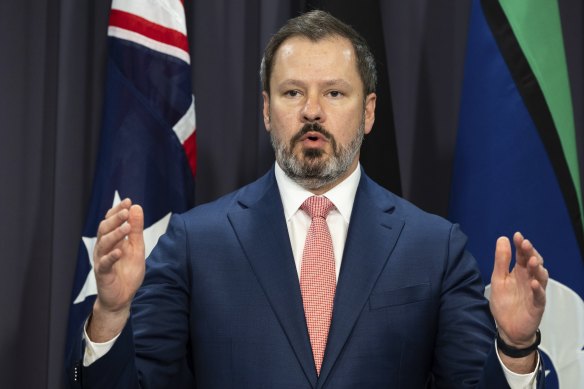Save articles for later
Add articles to your saved list and come back to them any time.
Investment deals in climate change and advanced technology are dominating the first 100 proposals for the federal fund that is meant to expand Australian manufacturing using a $5 billion cash injection from taxpayers.
The federal government made the payment to the National Reconstruction Fund on Monday to mark the first meeting of its board and the start of talks over the mandate that will help decide where it invests.
Minister for Industry and Science Ed Husic: “We want this to be a country that makes things.”Credit: Alex Ellinghausen
But the board and government are yet to determine the likely rate of return on the investments, which are meant to generate earnings that can cover the cost of the Commonwealth debt used to set up the fund.
Industry Minister Ed Husic, who was a guest at the first meeting of the fund’s board in Sydney on Monday, said the government would not tell it where to invest, although it would set the investment mandate in regulation.
“We’ve deliberately set the NRF up with an independent board. We want the board, made up of some really high-quality members, to be able to make those calls,” he said.
“We are making a clean break from what you saw out of the Coalition, using grants driven by political interest, to an NRF with an independent board making decisions in the national economic interest.
“So they will consider a range of factors, they’ll provide their advice, and we will take that advice as we settle the investment mandate.”
The board is chaired by lawyer and company director Martijn Wilder, who was a founding director of the Clean Energy Finance Corporation in 2012 when it was set up to produce a commercial return from investments in new projects such as renewable technology.
The corporation’s investment mandate, set in regulation, asks its board to target an average return of at least the five-year Commonwealth bond rate plus 2 to 3 per cent a year, but the reconstruction fund’s mandate could be lower if it is asked to make riskier investments.
The other members of the fund’s board are former Australia Post chief Ahmed Fahour, venture capital partner Katharine Giles, former Liberal cabinet minister Kelly O’Dwyer, tech industry executive and investor Daniel Petre, former Australian Workers’ Union national secretary Daniel Walton and company directors Kathryn Presser and Karen Smith-Pomeroy.
The board is expected to name an interim chief from the federal public service while starting a search for a permanent chief to help choose the first investments.
About 100 proposals have already gone to the fund and the government says the biggest sectors for these pitches have been advanced technology and climate change, such as renewable energy technology.
“It’s a milestone moment because not only is this the first time that the board’s met, it’s also the formal point at which authority is transferred out of the government to the independent board of the NRF,” Husic said.
“It’s also another step in delivering an important election commitment of the government – that’s a really, really big thing.”
The law to set up the fund, passed with the support of the Greens and opposed by the Coalition, sets out priority areas for investment including agriculture, medical science, energy, advanced technology manufacturing, defence and transport.
Labor went to the election with a promise to set up the fund and transfer $15 billion to the entity over time.
“We want this to be a country that makes things. So it’s about revitalising manufacturing, sharpening our technology edge and generating strong, secure, well-paying jobs for Australians,” Husic said.
Cut through the noise of federal politics with news, views and expert analysis. Subscribers can sign up to our weekly Inside Politics newsletter.
Most Viewed in Politics
From our partners
Source: Read Full Article



